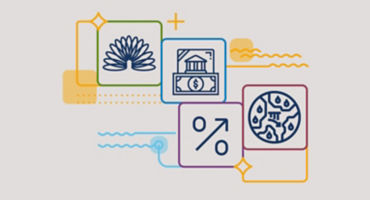- Investment Specialist
Skip to main content
- Funds
- Insights
- Capabilities
- About Us
- My Account
The views expressed are those of the author at the time of writing. Other teams may hold different views and make different investment decisions. The value of your investment may become worth more or less than at the time of original investment. While any third-party data used is considered reliable, its accuracy is not guaranteed. For professional, institutional, or accredited investors only.
After years of near deflation across much of Europe, the region is now witnessing persistent price increases. Second-order effects of recent geopolitical developments, particularly the ongoing war in Ukraine, are intensifying the current inflationary environment. This apparent shift to a higher inflation regime, with the resulting expectation of tighter monetary policy and rising interest rates, presents a material challenge for European fixed income investors, raising questions such as:
How best to answer these questions depends on the specific circumstances of each investor, but over the coming months, we aim to share some pointers to help European investors think through the implications of higher inflation for their fixed income portfolios. As a first step, let’s take a closer look at the challenges presented by today’s uncertain market backdrop.
Following the reopening of the global economy, markets have shifted their focus to how central banks plan to unwind monetary stimulus and respond to the new, more inflationary environment, with potential implications varying by asset class and region.
Fear of potentially derailing the economic recovery initially led global central banks to tolerate price increases well above their normal inflation targets, but faced with stubbornly high inflation readings, most have now changed course (albeit at different speeds). The tragic events in Ukraine have added another layer of uncertainty to the macroeconomic picture, but they have not (yet) altered our belief that investors should prepare for the end of accommodative monetary conditions and consider positioning their portfolio allocations accordingly.
For financial markets, one of the most striking implications of the Russia/Ukraine conflict has been the sharp upward moves in energy and other commodity prices recently. (Both countries are major global commodity exporters.) If anything, this has reinforced our outlook for higher short- and medium-term inflation and the resulting need for tighter monetary policy (including higher interest rates).
As world central banks react to inflationary pressures at different speeds, we see an increased likelihood of a divergence in interest-rate cycles. This may have ramifications for European assets and asset owners who seek to hedge their global portfolio exposures:
Ultimately, a myriad of factors and potential scenarios could impact fixed income returns over the short and medium term as we progress throughout 2022 (Figure 1).
In summary, the current global environment is characterised by widespread, rapid reflation and diverging central bank monetary policy responses, but also by heightened uncertainty around geopolitical risks. Despite the challenges posed by this environment, we believe market opportunities remain plentiful and the role of a diversified portfolio paramount for fixed income investors.
In practice, European investors have a variety of tools at their disposal to help navigate this global landscape, including mechanisms to defend against — and potentially take advantage of — rising inflation and interest rates. For example:
Given the number of “known unknowns” these days and the broad range of potential outcomes going forward, we encourage fixed income investors to be as flexible as possible and to consider adjusting their base cases (and their portfolio allocations) as new information arises.


URL References
Related Insights
Stay up to date with the latest market insights and our point of view.

Global Economic Outlook
Our macro strategists continue to expect that the interlinkages between countries, central bank policies, and market pricing will change, creating potentially attractive opportunities for active portfolio management and security selection.

Listening to voters’ economic concerns should mean less fiscal spending
Fixed Income Portfolio Manager Brij Khurana explains the likely economic and market impacts of Trump administration policies, including potential winners and losers from drastic fiscal spending cuts.

Navigating uncertain policy shifts
Macro Strategist Juhi Dhawan explains why investors should prepare for heightened volatility in 2025, due to significant policy changes under President-elect Trump that will impact inflation, trade, and economic growth.

New market regime, a new environment for global equities?
Global Equity Strategist Andrew Heiskell characterizes the new market regime, makes a case for shelving the old investment playbook, and shares potential investment implications for equity markets.

Private credit in a new regime
We explore how a shifting macro backdrop, ongoing banking crisis, and evolving competitive dynamics may create opportunities across private credit markets.

Inflation loosens its grip, but bank turmoil could put the squeeze on US growth
US Macro Strategist Juhi Dhawan weighs the benefits of disinflation for consumers and companies against the risks of a credit crunch brought on by the recent bank crisis.

Credit market outlook: Expect greater opportunities in back half of 2023
Against a backdrop of elevated recession risks and banking-sector stress, Fixed Income Portfolio Manager Rob Burn identifies relative-value sector opportunities in the credit market.

Fixed income 2023: Will opportunity keep knocking in the second half?
Learn where Fixed Income Strategist Amar Reganti sees opportunities in the fixed income market today and dive deeper into the three key themes he thinks investors should consider going forward.

A quiet bull market in EM local debt?
Brian Garvey illustrates the recent strength of emerging markets local debt following an extended period of underperformance.

Global high yield: Attractive entry points could soon emerge
Fixed Income Portfolio Manager Konstantin Leidman shares his outlook for high-yield fixed income for the rest of this year and beyond.

The “money illusion” economy: Misplaced faith in markets?
Fixed Income Portfolio Manager Brij Khurana shares a skeptical view of US Federal Reserve policy, his assessment of the current market backdrop, and his view of what the future could hold.
URL References
Related Insights